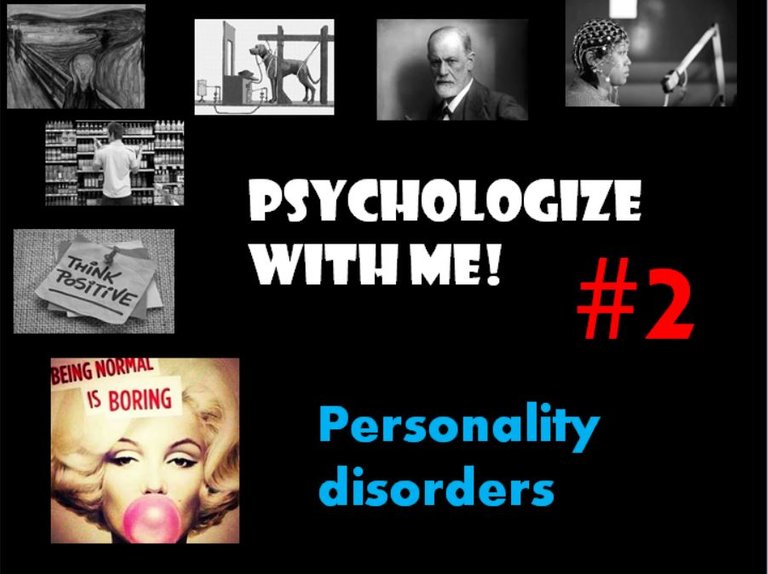Around 7% of the population can be diagnosed as having a personality disorder. And you surely know someone who constantly has problems with getting along with the other people since he or she was young. He may argue with different person every day, or not be able to stand up for himself. It can also be some overanxious person, or someone extremely manipulative. Those are the people whose differences in their social behavior, way of thinking, and expressing the emotions are obvious (and unpleasant) to almost everyone around. When you try to give them advices or to help them, there is no effect, so don't try again. They are not able to put themselves in other people's shoes, and that is why they always think that they are right, blaming the others for their own problems.
That is what the Diagnostic and Statistical Manual of Mental Disorders (DSM) published by the American Psychiatric Association (APA) says. As the existence of mental disorders is a questionable topic itself, as all the diagnoses are arbitrary (and being changed every few years by APA), and as psychiatrists are the only ones who give diagnoses, the purpose of this text is not to teach you how to put people from your environment into these categories.
So, this article is useless?!
Not at all! When you read this text, you will be able to understand people who posses such behavioral, thinking and emotional patterns, or being said more correctly, to recognize and understand such patterns in some people from your environment. More importantly, you will be able to make better relationships with them if you want, instead of rejecting or trying to change them.

Personality disorders can be defined as permanent and specific patterns of behavior, thinking, and emotions, that are different than those accepted by the culture. They are NOT mental illnesses, although some of them are usually combined with the serious psychological problems, such as depression, generalized anxiety, alcohol abuse, eating disorders, sexual dysfunctions, suicidal behavior etc. They are also usually followed by problems with friendships and work, family violence, and problems with the police. Such people are so persistent in what they want, that the others usually adjust to them. Since they always think that the problems lie in somebody else, it is very difficult, if not impossible to 'treat' their 'disorder'.
Here is how they can be classified in ten categories. Again, when you think of them, try to recognize these patterns in some people you know, instead of putting them in these categories.
Cluster A: 'odd', 'eccentric' cluster
These patterns are characterized by projection (attributing their own flaws to the other people) and fantasy mechanisms (creating the imaginary world in order to deal with one's own flaws and escape reality).
1. Paranoid

[Picture 'stolen' from mejorconsalud.com]
People possessing this pattern are overly suspicious, cynical, and interpreting other people's neutral comments and actions as malicious and threatening. They are irritable, and often angry. They tend to check their partners and friends for treason, and they are pathologically jealous. Emotionally they are cold, claiming for themselves that they are rational; they are also rigid, with lots of predjudices, and constantly in defensive mode. They avoid being close with others, as it can be threatening. They never forget or forgive real or misinterpreted offenses. They also excessively use projection.
2. Schizoid

Franz Kafka's personality could be portrayed as schizoid character; read more, for example, here [Picture 'stolen' from goodreads.com]
It is very likely that you will never meet such a person in your life, since they very really leave their home. These loners seem cold, distant, reserved, and self-contained, not showing any interest for the activities that are usually satisfying for the others. They are very introspective, and preoccupied with their fantasies, with very vivid imagination. Such a person has problems with establishing relationships with others, and they respond inadequately, showing neither friendliness, nor animosity. They can be very fond of animals. They are not interested in sexual activities including the other people. Schizoid characters prefer working solo, they don't care about competing with the others, and they usually engage with abstract things, such as physics, math, or philosophy. Many of them are famous scientists or writers.
3. Schizotypal

[Image 'stolen' from astrology.com.au]
These people can be real eccentrics! They believe in magic, telepathy, clairvoyance, illusions, sixth sense, and their behavior is usually strange to the people from their cultural environment. They interpret the situations in different, and odd way. Their clothing usually looks unusual, their talk is often confusing to the others, and sometimes they talk with themselves. They also prefer to be alone, as they feel uncomfortable with the other people, and sometimes they have paranoid ideas.
Cluster B: 'dramatic, emotional, and erratic cluster'
People with the patterns from Cluster B usually use dissociation (neglecting their own ideas, memories, feelings, or even whole identity), denial (refusing or not being able to admit some one's own idea or feeling), splitting (seeing people as only 'black or white'), etc.
4. Borderline

It is believed that these two celebrities suffer(ed) from Borderline Personality Disorder [Picture 'stolen' from http://blog.everlasting-star.net]
People with the borderline personality are stable in their instability. They have instable and very intense relationships, where they are constantly shifting between love and hate for the other person. They can be excessive in eating, spending, sex, fast driving, substance abuse, and have lots of conflicts. These people have extreme mood swings, even during one single day, so that they can quickly change from feeling very down and hostile, to being happy and friendly. Their behavior is unpredictable to the others, and their interpretations of reality are turbulent and unstable. People with borderline traits cannot control their emotions, so they often have inadequate rage outbursts. They don't have any long-term plans or goals, are not sure what they want from themselves and from the others, and they don't have a stable sense of identity. They also chronically feel empty, can't stand being alone, and are constantly in fear that their family or friends will leave them.
5. Histrionic

[Picture 'stolen' from novi.ba]
The name of this personality disorder stems from Latin word 'histrion', which means 'an actor'. And really, lots of people with this personality type are actors or other celebrities. They are prone to capricious behavior, and their emotions are expressed in very extroverted and dramatic way. They have very strong need for attention, and are very charismatic and seductive. They also tend to sexualize social relationships. On the other hand, people with histrionic personality can be egocentric, vanitous, manipulative, and with rage outbursts. They are extremely dependent on the others, and can get close very quickly, being easily influenced. However, their relationships are mostly superficial. They are full of energy, and often bothering others with their demands.
6. Narcissistic

[Picture 'stolen' from commons.wikimedia.org]
Narcissistic people crave constant admiration. They love to be seen, so they do everything to get attention. They have extreme sense of their own value, and they demand from the others to treat them in the same way. They seem very charming and attractive, socially adapted, but it is only the surface - deep inside they feel completely inferior. They often try to appear as modest and devoted to the others, however they are cold, egocentric, lacking the empathy, and tending to put the others down. They often exploit or use the others, and are also good manipulators. They are not really able to love. When their self-respect is threated, they get very angry. As they see themselves are superior, they often become famous.
Antisocial

[Picture 'stolen' from businessinsider.com]
This personality disorder is also called sociopathy, psychopathy, amoral, etc. Antisocial people have no feelings of guilt and empathy. They are manipulative, demanding, irresponsible, rejecting social norms, and harming their own, as well as security of the others. They often abuse their family members. Even when they are very young, they deceive, thieve, run away from home, abuse drugs or alcohol, and have troubles with the law. They usually blame the others for their own faults. They are agressive, can't control their impulses, or worry about the consequences.
Cluster C: 'anxious, fearful cluster'
For this category of personality disorder, isolation mechanisms (separating unacceptable ideas or behaviors from the emotions), passive aggression, and hypochondria.
7. Dependent

[Picture 'stolen' from blic.rs]
These people have no self-confidence, and that is why they have need to submit to the others, and let them decide for them. They don't believe in themselves, they are pessimistic, and easily abandon on their goals. They are very dependent on the others, relying on their advices and support, and putting responsibility on them. They are afraid that people will leave them, thinking that they are not able to take care about themselves. Dependent people can't express anger, so they 'agree' with everything, while actually being unhappy in relationships (an example is a woman who can't leave the abusing husband). They are a good match with narcissistic people.
8. Obsessive-Compulsive

[Picture 'stolen' from readersdigest.ca]
These people are extreme perfectionists. They are preoccupied with tidyness, details, and rules. They are overly responsible, hardworking, feeling uncomfortable with the fun and rest. With the other people they are serious, rigid, not willing to compromise, and not liking the jokes. They are usually well adapted in family and at work, but having very few friends, since every change makes them insecure and worried. They have lots of rituals in their behavior, such as putting the things always at the same place.
9. Passive-Aggressive

[Picture 'stolen' from http://andiamocreative.com]
Passive-aggressive people are not able to express their anger or unfriendly feelings towards someone, and they try to tend kind and polite. Their negative feelings they express rather indirectly - by annoying behavior, criticising irrelevant actions of the other person (not those that really bother them), ignoring responsibilities or agreements, etc. So, their speech is often different than their actions. They tend to procrastinate, waiting for the others to complete their tasks, saying that they forgot or misunderstood something. Passive-aggressive people blame the others for all their faults, and ignore authorities.
10. Avoidant

[Picture 'stolen' from finest.se]
People with avoidant personality patterns are overly sensitive, and can easily feel rejected or insulted. They have a big fear of rejection and bad judgements, being afraid that their behavior is wrong, stupid, or embarrassing, so they act shy. They can't stand even smallest criticism. These people have very few friends, and don't make new friends easily. Their self-confidence is very low, making them feel generally incapable. Because of their social anxiety, they avoid public places, so that they make sure they will not do something embarrassing in front of the others. More extremely, avoidant people can come to the point when they stop going to work, for shopping, or anywhere else outside.
Women are more frequently diagnosed with borderline, histrionic, dependent, and avoidant personality disorder, while men more frequently get antisocial, obsessive-compulsive, and schizoid personality disorder diagnoses.
Question for you:
As maybe a non-psychologist, but hopefully a careful observer of the people around, would you consider these personality disorders as 'disorders', or 'personality types', 'characters', or as anything else?
Let me know what you think, and in one of the following articles I will discuss the existence of the mental disorders!
Katarina Milivojević
Please upvote this post if you liked it, and follow me for more articles in psychology, as well as my travel stories. Also, leave a comment to let me know what you think ('cause pretending to care makes me happy).
If you liked this post, you may be interested in the following one:
What is worst is to be on a borderline. Borderline spectrum of disorders (excuse me if I use wrong terms, I am not an expert), like what I have make a person partly limited regarding everyday abilities and potentially harmfl. I am one such case and often I do bad things out of clumsiness, which is related to non-psychiatric disorders I have, such as amblyopia.
What is worst is that people with mild psychiatric disorder manifestations cause a big dissappointment among their closest relatives. Parents can despise you just because you did not meet their expectations. Instead of helping and being understanding they make things even worse. Mental disorders, at least those that do not make a person with a disability, require UNDERSTANDING. But some parents are obnoxious, as described by Susan Forward, and they're even harming mentally fit children.
Hi @miroslavm, thank you for the useful comment, and for sharing your experiences! It is true that mental disorders, and especially those issues that cannot be classified as real disorders, require understanding, for making better relationships with the people close to us.
Susan Forward is a great author, I'm glad you had a chance to read her writings!
Recommendation for your next topic on Psychology: the so called energy vampires. Who they are, what defines them, and how not to become one.
cool, I'll write about it in one of the next articles! :)
Very well said! Its such an interesting topic about personality types and disorders. Makes me sad to think that people around the world are still ignorant with these mental challenges. The more we will understand these differences,the more we could stop the stigma about mental health issues.
Yes, I totally agree!-That is why I am planning to discuss whether mental illness is real or not :)
Wow that would be a great article.
I have always found personality disorders (PD) fascinating so I appreciate this post. I think understanding a personality disorder can especially be empowering to those who have been raised by someone with a PD . There are many books out there for children of a borderline parent who often have a chaotic childhood. Nonetheless, there are a few corrections I want to make from your post.
One does not need to be a psychiatrist to diagnose someone with a personality disorder. A psychologist, clinical therapist, or clinical social worker can also make this diagnosis (at least in the USA - not sure about other countries). This is a good thing because psychotropic medications cannot fix a personality disorder, and psychiatrists typically do not provide therapy but instead focus on prescribing medication. Although medication can be helpful in managing symptoms related to the personality disorder (i.e. depression, anxiety, substance use), for some reason people with a personality disorder do not respond as well to medication as the client without a personality disorder. https://psychcentral.com/lib/treatment-for-antisocial-personality-disorder/
A personality disorder IS a mental illness, and a serious one at that. https://healthcommkey.org/how-are-personality-disorders-different-from-mental-illnesses/
According to the DSM 5, Passive Aggressive (although highly irritating) is not a personality disorder but instead a behavior that can be seen in some personality disorders.
I read somewhere that 1 out of every 20 people can be diagnosed with a personality disorder, but as a clinical therapist myself I find this number to be a bit high - unless they are also counting people with only features or traits instead of meeting the criteria for a full blown personality disorder. Most personality disorders are so hard to treat, but there are some therapeutic treatments that have proven to be helpful for certain disorders (i.e. DBT for Borderline Personality Disorder). However, from what I have heard (and through my own personal experience) talk therapy unfortunately can be counterproductive for the narcissistic sociopath.
Thanks for sharing, @zheimberg!
It is increasing day by day . New here need your support .
good luck!
Thanks
This post has received a 15.66 % upvote from @boomerang thanks to: @katarinamiliv
Nice pictures to demonstrate the personality disordersa. But I don´t think Monroe qualifies for borderline...
thanks!
Angelina Jolie - definitely, but I was thinking the same thing about Marilyn Monroe ... but I found this article and, if true, some are surprising (and some not so much). https://www.addict-help.com/mental-disorders/personality-disorders/borderline-personality-disorder/
Beethoven
Winston Churchill
Princess Diana
Adolf Hitler
Marilyn Monroe
Britney Spears
Mike Wallace
Amy Winehouse
Lindsay Lohan